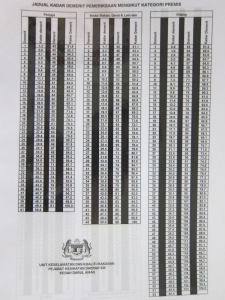DAY 13
Visited DHO and Jeniang Clinic
Our journey started with a sunny day. We reached our destination at 8.25am. Before the session started, a few of us went to pharmacy to take a picture of soft gel, and a picture of Advanced Quality Rapid Anti-HIV (1&2) test kit. The officer who is in charge in the laboratory department showed us the kit. He asked one of us to be a volunteer for the Rapid HIV test as the test kit is sealed in a sterile plastic packet. Once it is opened, it must be used.
Intended Use:
Advanced Quality Rapid Anti-HIV (1&2) test is a colloidal gold enhanced, rapid immunochromatographic assay for the qualitative detection of antibodies to human. Immunodeficiency virus (HIV) in human whole blood, serum or plasma. This test is a screening test, and all positives must be confirmed using an alternate test such as western blot. The test is intended for healthcare professional use only.
Summary
1. The human immunodeficiency virus (HIV) is the causative agent of acquired immune deficiency syndrome (AIDS).
2. The general method of detecting infection with HIV is to observe the presence of antibodies to the virus by an EIA method followed by confirmation with Western Blot.
3. The Rapid Anti-HIV (1&2) Test is a simple, visual qualitative test that detects antibodies in human whole blood, serum or plasma. The test is based on immunochromatography and can give a result within 15 minutes.
Principle of the procedure
- The assay starts with a sample applied to the sample well and add provided sample diluent immediately.
- The HIV antigen -colloidal gold conjugate embedded in the sample pad reacts with the HIV antibody present in whole blood, serum or plasma sample forming conjugate/HIV antibody complex.
- As the mixture is allowed to migrate along the test strip, the conjugate/HIV antibody complex is captured by a second antibody immobilized on the membrane forming a colored test band in the test (T) region.
- A negative sample does not produce a test band due to the absence of colloidal gold conjugate/HIV antibody complex.
- The antigens used in the conjugate test are recombinant proteins that correspond to highly immunoreactive regions of HIV1 and HIV2.
- A colored control band in the control (C) region appears at the end of test procedure regardless of test result. This control band is the result of colloidal gold conjugate binding to the anti-HIV antibody immobilized on the membrane. The control band indicates that the colloidal gold conjugate is functional.
Reagents and Materials Supplied:
– Test cards individually foil pouched with a desiccant.
– Plastic dropper
– Sample Diluents
– Safety lancet
– Alcohol swab
– Package Insert
– Plastic Pipette to dispense sample
SPECIMEN COLLECTION
1. Clean the area to be lanced with an alcohol swab.
2. Squeeze the end of the fingertip and pierce with the safety lancet as instructions below.
Assay procedures
- Dispense 1 drop (10 µl) of whole blood, serum or plasma to the circular sample well of the test card using the plastic dropper provided according to the figure.
- Add two drops of Sample Diluent to the sample well immediately after the specimen is added.
- Interpret test results at 15 minutes.
Reading the test results:
- Positive: Both purplish red test band (T) and purplish red control band(C) appear on the membrane. The lower the antibody concentration, the weaker the test band.
- Negative: Only the purplish red control band (C) appears on the membrane. The absence of a test band (T) indicates a negative result.
- Invalid: There should always be a purplish red control band in the control region regardless of test result. If control band (C) is not seen, the test is considered invalid. Repeat the test using a new test device.
Note: It is normal to have a slightly lightened control band with very strong positive samples as long as it is distinctly visible.
Limitations
1. Only samples that are clear and with good fluidity can be used in this test.
2. Fresh samples are best but frozen samples can be used. If a sample has been frozen, it should be allowed to thaw in a vertical position. Do not agitate the sample. Insert a pipette just below the surface of the sample to collect the specimen.
After that, we went back to the Meeting Room. The speaker of the day was PPKP Mr. Muhamad Fahmi. He briefly talked about Non-Communicable Disease (NCD) unit. He explained about the jobs and responsibilities of the unit. He is also in charge in the enforcement of Tobacco Regulation.
Next, he introduced us about Klinik Berhenti Merokok (KBM), Quit Smoking Clinic.
Quit smoking clinics are available in hospitals and health clinics to help smokers to quit smoking with proven techniques that is behavior modification therapy and nicotine replacement therapy. There are 2 Quit Smoking Clinics in Sik. One in KK Jeniang, another one is in KK Gulau.
Mr. Fahmi is also in charge in monitoring nurseries, kindergarten, PASTI, and private nurseries (whether the premises are safe to be used, monitors the cleanliness of the premises, any cases of Hand, Foot, and Mouth disease in these premises.)
Besides, he also cooperates with Pegawai Zat Makanan in BMI Screening Weight Management.
After the talk, we went to KBM in KK Jeniang. This KBM started in 2009 in KK Jeniang.
Procedure:
Registration of the smokers
Evaluate any risk factors (DM, HT, etc)
Blood is taken for lipid profile (counseling is given by Medical Assistant)
Medical Officer (counseling and decides which therapy to be given to the smokers)
For beginners: Behavior modification therapy
For heavy smokers: Nicotine Replacement therapy
Mr. Azrullah explained about Champix (tablets used in Nicotine Replacement Therapy). Each tablet is 1mg. This therapy is indicated for heavy smokers (30 sticks/day). Those who are not heavy smokers, they will undergo behavior modification therapy.
The following is the dosage of the tablet to be taken:
1st 3 days – 0.5mg OD
4th-6th days – 0.5mg BD
7th day onwards – 1mg OD
Duration of each cycle is 2 weeks. After 2 weeks, Mr. Azrullah will assess the smoker. If the smoker is able to quit smoking after taking Champix for 2 weeks, this indicates he succeed in quit smoking program. However, if he is not able to quit smoking after taking Champix for 2 weeks, this therapy will continue for 6 months. Maximum duration of the therapy is 6 months. If he is still unable to quit smoking after 6 months of therapy, the result is considered as failure.
Mr. Fahmi explained to us how to define a person who quit smoking. It is defined as a person who does not smoke for 6 months from the day he starts the treatment.
That’s all for today.
Day 10
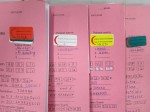
16/10/2011 : STI
STI screening
Sexually transmissible infection is one of the major concern in Kuala Muda district. It is very difficult in identifying cases of STI due to its social implication that places on the individual and also the lack of knowledge about the disease. So, there are only few cases that could be identified just like a tip of an iceberg and a lot more cases are yet to be identified.
There are more than 20 STI in Malaysia , but the most common STI are:
- Gonorrhea (commonest in Malaysia)
- Chlamydia
- Syphilis
- Candidiasis
- Genital herpes
- Trichomoniasis
- Channcroid
- LGV
- Granuloma inguinale
One of the major drawback in identifying STI cases is the limited test that are available to perform. Most of the screening or confirmatory test are not performed or only certain government health facilities have them because they are expensive and government cannot afford to spend so much on tests alone.
Besides that, an individual with STI normally affected by more than one infection. Example, most of the time Gonorrhea, Chlamydia and Candidiasis occur together at the same time. Therefore, identification or confirmatory test become more difficult.
Therefore, modified syndrome approach(MSA) is used widely in Kuala Muda district to tackle STI cases. MSA is approach where infections are grouped into similar signs and symptoms. There are 4 main syndrome:
- Vagina discharge syndrome
- Urethra discharge syndrome
- Genitalia ulcer syndrome
- Asymptomatic cases
Patients who are at high risk of getting STI and patients who show symptoms of STI are screened. High risk groups are:
- Injecting drug use
- Homosexual /MSM ( men sex men)
- Multiple sex partners
- Vertical transmission
- Blood/organ transplant ( least common)
Lab test
1) Vagina discharge syndrome
- Wet mount for T.vaginalis( swab vagina)
- Gram stain for C.albicans & “clue cells”/ Gonococci (swab vagina)
- Culture for Gonococci (swab cervix)
- HIV antibody
- VDRL/RPL
- TPHA
- Anti-Hev
- HBsAg
- Pap smear
2) Urethra discharge syndrome
- Gram stain
- Culture
- Two-glass urine test
- HIV antibody
- VDRL/PRL
- TPHA
- Anti-Hev
- HBsAg
3) Genitalia Ulcer syndrome
- HIV antibody
- VDRL/RPL
- TPHA
- Anti-Hev
- HBsAg
- Pap smear
4) Asymptomatic cases
- Pap smear
- Contact
- Other presentation
Treatment
1) Cervicitis and vaginitis
- IM Ceftriaxone 250mg OD
- Oral Azithromycin 1gm OD
- Oral Metronidazole 2gm OD
- Pessaries Clotrimazole 200mg tds / 500mg OD
2) Vaginitis only
- Oral Metronidazole 2gm OD
- Pessaries Clotrimazole 200mg tds/ 500mg OD
3) Gonorrhea and chlamydia
- IM Ceftriaxone 250mg OD
- Oral Azithromycin 1gm OD
4) Chlamydia only
- Doxycycline 100mg bd PO 1 week or
- Oral Azithromycin 1 g OD
5) Trichomonas Vaginalis
- Oral Erythromycin ES 800mg qid 10-14 days
- Oral Metronidazole 400mg bd 5 days
6) Shyphilis and chancroid
- IM Benzathine penicillin 2.4 million OD 7 days for 2 weeks
- Oral Azithromycin 1gm OD
If allergic to penicillin
- Oral Doxycycline 100mg bd 14 days
- Oral Azithromycin 1gm OD
17/10/11 Methadone replacement therapy
Harm Reduction Program, including:
(a) Methadone Replacement Therapy
(b) Program of syringe exchange
Today we will be focusing more on Methadone Replacement Therapy. This program started since 2008 and it is run by one FMS, one MO one AMO and one staff nurse. It is a cooperative program with Agensi Anti Dadah Kebangsaan (ADK).The objective of this program is to prevent transmission of HIV to other people. It is not a program for rehabilitation.
Below is the carta alir pemilihan perserta metadon. First of all, patient will go to ADK to report themselves as drug addicts. The ADK will then refer them to Klinik Kesihatan for screening (Liver Function Test) to be done. Those with a normal LFT results will be reviewed by medical officer for the dosage of methadone required. New patient will be sent to intoxication room for 3 – 4 hours to observe if there is any side effects.

Total number of registered patient is 112 people, inclusing 78 active cases and 34 defaulted cases(patient enter prison or unable to contact patient). the youngest patient is only 16 years old while the oldest patient is 68 years old.
Urine test must be done everyday for the first 2 months. Those with 3 times urine positive will no longer be entertained by the clinic.
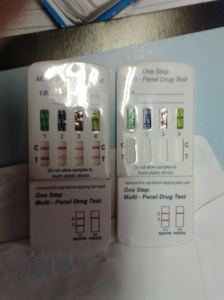

to test the presence of methadone in patient's urine. a negative result indicates that patient is not using his own urine for the urine test.
On the other hand, the first 2 times of LFT should be done half year once. if the results are all normal, LFT should be done one year once. LFT should be done immediately if the patient complaints of any withdrawal symptoms.
Patients with unstable condition are required to come back to KKISP everyday for their methadone replacement. First of all, they have to write their names in one record book which will help the staff to ensure that all the patients go to the pharmacy to take the methadone.
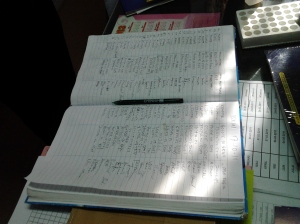

patients namelist in pharmacy. Pharmacist will tick the patient's name once the come to take their methadone.
Each patient will have their own cup to take the methadone.

In the pharmacy, the pharmacist will prepare the methadone according to dosage required by each patient.

Above is a video showing how the pharmacist prepare methadone.
For patients with stable condition, they are allowed to take the methadone back home and drink by themselves. The number of patient under DOT is 53 and the remainders are under stable condition.
The major problem face by this program is the difficulty to handle patients. Most of them are not cooperative and some of them even have aggresive behavior. As an example, some patients used other people’s urine for urine test in order to get a negative result. Some patients bring back methadone and sell it for RM30.
Is that morsel of food really safe???
On Thursday, the bunch of us from group F were sitting in the meeting room in the District Health Office in Sik. We had heard rumours that an officer would take us to the field to collect food samples as part of our exposure on Food Quality Control. Evidently, this was the part of the posting that most of us were looking forward most to. We were chatting animatedly discussing the possibility of the rumour being true.
Our friendly chatter was interrupted around 9am when Saundari barged into the room and announced nonchalantly that we were to gather our things and follow 2 officers to collect food sample in some school around that area. That was the fastest I’ve seen any of my classmates packed their things (yes, faster than when it was time to go home).
So 3 cars followed a four wheeled drive driven by Mr. Dzulkifli (the “D” is silent) and Mr. Omar. After a distance of around 7km, we arrived at a large partial boarding school (partial as in living in the hostel is optional) in the middle of what seemed like a large abandoned but wildly beautiful garden.
In Sekolah Menengah Sungai Cepir, we gathered in the school canteen. To be split into 2 groups. My group went with Mr. Omar first. He was to show us how to evaluate a premise to ensure food safety.
I thought the canteen looked clean enough, with cheerful but rather distasteful plastic table cloths on the tables and walls that seemed like a paint eating dragon barfed all over them. One or two flies were wandering around, but from first inspection, my untrained eyes were impressed as I have eaten in worse places. However, I learnt that a general inspection was just the start of the procedure.
We were taken into the kitchen to evaluate everything from their cooking utensils to their footwear. I believe the criteria we were looking for will be covered in detail by the group who will be presenting of Food Quality Control. Suffice to say we learnt that food safety is an important part in keeping a community healthy. An important criteria in the evaluation forms were the vaccination statuses of the canteen workers which were to be kept available for inspection at any given moment.
Mr. Omar was kind enough to allow us to fill in the evaluation form with his assistance and supervision. All in all, the school canteen did rather well.
When that was over, we marched in a single file toward the hostel where Mr. Dzulkifli was waiting for us in the dining hall of the hostel. We waved to a group of firefighter cadets who were literally marching, unfortunately distracting their attention eliciting a rather harsh scolding by their leader :’(, but I digress. We were then taken into the kitchen where 3 ladies were busy chopping and pounding in preparation for the day’s lunch.
Mr. Dzulkifli gave us a short briefing about collecting food samples and the proper procedure to do so, which again, will be covered in detail by the relevant group. But in short, we were told the basic principles of the procedure which was 1) always carry your authority card and explain the procedure to the caterer, and 2) avoid contaminating the food samples.
Rule number 1 is self explanatory.
To avoid contamination, several measures were taken. Mr. Dzulkifli demonstrated a step by step procedure beginning with donning a disposable apron (non sterile), sterilizing the hands with an ethanol based sanitizer and wearing sterile rubber gloves. He then proceeded to demonstrate how he would collect the sample (a starfruit) with the instruments he brought, and how it is to be packed in a sterile clear bag while stressing on the importance of labeling.
We were preparing to leave after the demonstration when a friendly mak cik who was the canteen operator firmly insisted that we stay for a cup of tea. As she would hear nothing of us leaving without taking at least a sip of the milk tea she graciously prepared, we sat down in the kitchen with Mr. Dzulkifli and chatted with him on a more personal level. Fun
Day 9 in Sik
We started our journey to sik at 7am from aimst.. We reach there sharp 8am and Mr. Jamil the incharge of CDC already waiting for us in PDK to bring us to Hospital Sik. It was situated 3km from the PDK. Even though the hospital is small, the surrounding was beautiful and it is maintain well.
Firstly, when we reach we went to the pulmonary clinic and meet with sister Mariam. She explain to us about DOT. Then, we were brought to male ward to meet the medical officer in charge (Dr. Tin Soe). He briefly explain to us about pulmonary tuberculosis and we were given chance to clerk a TB patient.

After that, we when to the pharmacy of Hospital Sik. There, we get to know the organization of pharmacy, the method of packing tablets and colour coding of the drugs available there.

From Hospital Sik, we when back to PDK to meet Mr.Asri in charge of BAKAS (Bekalan Air dan Kesihatan Alam Sekitar). He explain to us method of rural water supply and disposal of waste water. Then, we continue our journey to Kg. Dua to see their water supply and subsidized toilet.

That’s the end of our day there in sik.

Program Warga Emas in Klinik Kesihatan Bukit Selambau
Today’s trip was a very enjoyable one to all of us in group F1, though the trip to KK Bkt Selambau was far n tiring, it was worth the journey it took.
Today’s activity is to visit the Program Warga Emas in KK Bukit Selambau. We gathered at KK Bandar 8o’clock in the morning, then we followed En Yusof, who was today’s activity person in charge to KK Bkt Selambau.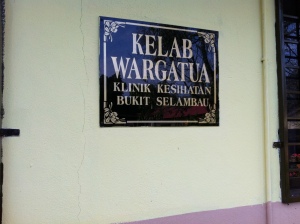
Immediately after reaching at KK Bkt Selambau, we were introduced to a few of the Kelab Warga Tua members
and the president for the club, Pn. Fauziah. At the mean time, another group was setting up PA system for some morning exercise. The atmosphere was so welcoming that we immediately felt like at home. We joined the club for some exercise, and we enjoyed the moves very much. The folks are creative bunch, as we can see from the moves they did for the morning exercise, which include the chicken dance song, Silat-tai chi style movements, movements assimilate ‘menuai padi, petik mangga’ and et cetera with songs of fast rhythm and they are real energizers.

Members of the club have to pay RM 2 per month as membership fee and the money will be collected by the treasurers to be deposited in the bank, and when the time comes, the money will be used to buy necessities like cooking ingredients for celebration purpose. The club celebrate Hari Raya, farewell party to fellow members who are moving to other places, a few other special occasions like today. The club is not a welfare group, it does not provide monetary support, however it does function as a social support group to support it’s member’s emotional, mental and physical health. For instance, it is a very good defaulter tracer for chronic diseases like hypertension and diabetes according to En. Yusof.
Caption: Hand-made Tudung Saji and Kompang by the club members.
The club usually gather on Sunday, Tuesday, and Thursday. Sunday and Tuesday are exercise days. The folks will gather at Kelab Warga Tua, KK Bkt Selambau at 8am and then the exercise continue until 10am. Usually they will be exercising indoor, following the aerobic steps as shown in the television and only during certain occasion that they exercise outdoor, like today. Whereas on Thursday, it’s ‘other activities’ day, which include religious talks, handy-craft session, Kompang and Nasyid practice, cooking classes, and et cetera. Besides all the fixed activities on fixed days, the members can come on other days to use the exercise equipment. These equipment are sponsored by the government as a gift upon the establishment of Kelab Warga Tua. These equipment consists of treadmill, bicycle, pedals, and gymnasium ball. However, it is regret to report that currently they do not have any professional trainers or physiotherapist to guide them with those equipment, therefore they only uses the equipment as per their capability.

In addition to the routine activities on fixed day, the club has other activities as well. For instance, it’s part of the club’s habit to constantly invite nutritionists, health officers, family medicine specialist to speak during health talks. Topics ranging from diet to information regarding chronic diseases. Besides that, just recently, they had went on an expedition to visit the Paddy Museum. Last year, 20 club members participated in the Hari Warga Emas which is a national event held in Rumah Seri Kenangan Cheras in KL.
After the talk and Q&A sessions with the folks, they invited us to have breakfast. All the food were cooked and prepared by the members of the club.
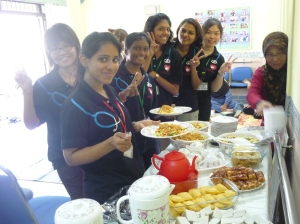
The feast began after the informative talks regarding Program Warga Emas in KK Bkt Selambau by En Yusof, Ms Ponnu, and Pn Fauziah.
It was not a coincident that Geetha’s birthday fall on that day, and so the feast was especial prepared for her. ^^
Happy Birthday Geetha !!!
DAY 8 IN SIK…
DAY 7
It’s another fascinating day at Sik DHO. Birds were chirping, the cool breezy weather along with the nice scenery of Sik mountain…Also not to miss out the happy faces on methadone unit participant who just received their methadone syrup after some industrious social work at Sik DHO.(more will be explained by my fellow group mates on the subtopic Methadone Programme) 🙂 Well, the day starts off with the introduction of communicable disease control by PPKP Jamil Osman. Attached below are what he explained to us:
The main mission of the unit is to prevent/control the occurrence of any communicable disease and they were regulated under Prevention and Infectious Diseases Control ACT 1988. Whereas the duties and the roles of the unit includes:
- Case recording for observation
- Analysis of data collected
- Investigation/detection of case
- To plan out preventive method
- To obtain a specimen/sample
- To prepare reports
- Receive orders from higher authorities
Communicable diseases that are controlled and monitored by the unit includes;
- Water and air borne diseases
- Vector borne diseases
- Diseases transmitted by animals
- Diseases that can be prevent through vaccination
- Tuberculosis and Leprosy
- Sexually Transmitted Diseases (STD)
- HIV/AIDS
- World health
- Outbreak of unknown and new diseases



















